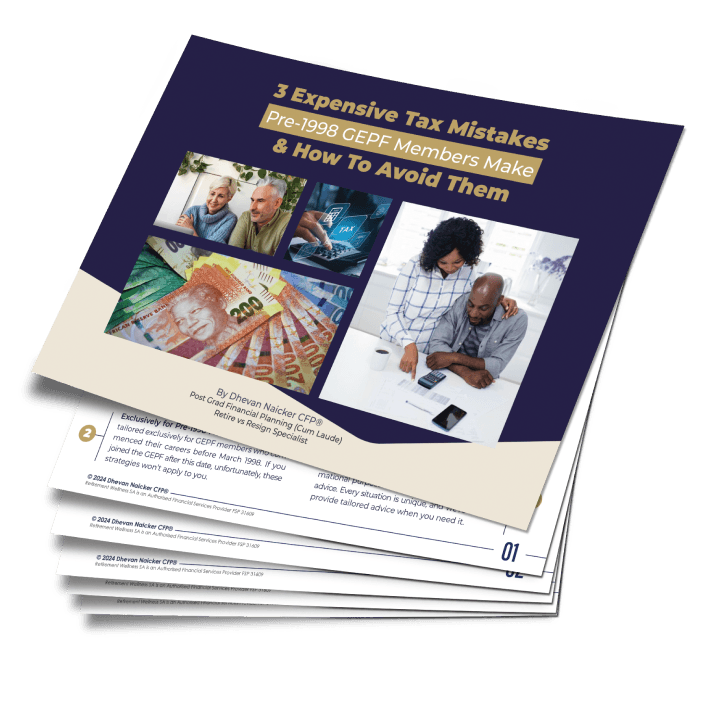Imagine this: you’ve meticulously planned your taxes, calculated your retirement payout, and eagerly awaited that SMS confirming your lump sum. But when the message arrives, your payout is tens of thousands of rands less than expected. This isn’t just frustrating—it’s financially devastating. Unfortunately, this scenario is far too common for government employees navigating their resignation or retirement benefits.
Take Paul, for example, a government employee who recently contacted me, shocked that SARS had taken over R100,000 more than he’d planned from his retirement benefit. While I wasn’t involved in Paul’s initial planning, his situation uncovered a common and costly mistake many government employees make when calculating their gratuity or resignation benefits. Let’s break down this mistake and show you how to avoid it.
Understanding the Tax Guide
When planning your taxes, always ensure you’re using the latest tax guide. For this discussion, we’ll refer to the 2024 tax year guidelines. The critical section to note is the Lump Sum Fund Benefits table, which outlines tax-free thresholds and sliding scale percentages:
- R0 – R550,000: 0% tax
- R550,001 – R770,000: 18%
- R770,001 – R1,155,000: 27%
- Above R1,155,000: 36%

Paul’s Mistake: Misinterpreting the Tax-Free Threshold
Here’s where Paul went wrong. He subtracted the R550,000 tax-free amount from his total lump sum before applying the tax table. For example:
- Paul’s gratuity: R1.5 million
- Paul calculated: R1,500,000 – R550,000 = R950,000
Using the tax table, Paul then applied the 27% tax bracket for amounts above R770,000, arriving at a total tax of R88,200. However, this approach is incorrect because SARS already accounts for the R550,000 tax-free portion within their sliding scale. By subtracting it again, Paul’s calculation severely underestimated his tax liability.
The Correct Calculation
Let’s calculate Paul’s tax liability correctly:
- First R550,000: Tax-free.
- Next R220,000 (R550,001 – R770,000): Taxed at 18% = R39,600.
- Next R385,000 (R770,001 – R1,155,000): Taxed at 27% = R103,950.
- Remaining R345,000 (above R1,155,000): Taxed at 36% = R124,200.
Total tax = R39,600 + R103,950 + R124,200 = R267,750.
Paul’s actual tax liability was R267,750, not the R88,200 he’d calculated. This discrepancy of nearly R180,000underscores the importance of accurate tax planning.
Other Critical Factors to Consider
1. Retirement Annuities and Pension Funds
Lump sum benefits from retirement annuities, pension funds, provident funds, and preservation funds all count toward your tax calculation. Failing to account for these additional contributions can significantly increase your tax liability.
2. Pre-1998 Tax-Free Benefits
If you began working before March 1, 1998, you may be eligible for tax-free benefits on a portion of your payout. These benefits can be a game-changer in reducing your tax liability but require careful calculation to ensure they’re utilized effectively.
3. SARS’ Sliding Scale
SARS calculates taxes on a sliding scale, which means higher payouts are taxed at progressively higher rates. Misunderstanding this structure can lead to significant underestimations of your tax liability.
4. Additional Lump Sums
Remember to include any severance packages or bonuses received, as these amounts will also be factored into the SARS sliding scale.
Practical Tips to Avoid Costly Mistakes
Tax planning is a complex process that requires expert guidance. While understanding the basics is essential, navigating tax tables and directives can be daunting for those unfamiliar with the process. Here are a few actionable tips to ensure you’re not caught off guard:
1. Engage a Professional
Consult a qualified financial planner who specializes in tax planning for government employees. An expert can identify hidden tax-saving opportunities and help you navigate the nuances of SARS’ tax tables.
2. Leverage Online Calculators
Use reputable online tax calculators designed for retirement planning to get a preliminary estimate. These tools can provide a clearer picture of your potential tax liability.
3. Plan Early and Regularly
Proactive tax planning can save you thousands of rands. Review your financial position annually, factoring in changes to tax laws and personal circumstances.
4. Review SARS Directives Carefully
Before accepting a directive, double-check all calculations with a professional. Mistakes can be costly, and directives are final once issued.
5. Keep Accurate Records
Maintain detailed documentation of all retirement contributions, employment dates, and any tax-free benefits. These records will streamline calculations and ensure you don’t miss any exemptions.
Maximize Your Savings
Proper tax planning can save you hundreds of thousands of rands, leaving more money in your pocket for your retirement. If you’re unsure about your calculations or want to explore tax-saving strategies, consider scheduling a consultation with a financial planner. Expert guidance can help you avoid mistakes and ensure you’re making the most of your hard-earned money.
Don’t let a lack of planning cost you your financial peace of mind. With the right approach, you can retire with confidence, knowing you’ve maximized your benefits and minimized your taxes.
Disclaimer: Retirement Wellness SA is an Authorised Financial Services Provider – FSP 31609. The information provided here is for educational purposes and is not offered by or on behalf of the Government Employees Pension Fund.

